Cloud-CRM, Enterprise 2.0 Tools: Needs, Challenges, and Strategies
VerifiedAdded on 2019/12/03
|13
|3438
|93
Report
AI Summary
This report delves into the realm of knowledge management and information system strategies, focusing on Cloud-CRM and Enterprise 2.0 tools. It begins by outlining the requirements of Cloud-CRM, its role in enhancing customer communication, and the challenges associated with its implementation, such as connectivity problems, client database maintenance, and security issues. The report then explores solutions to these challenges, including the use of secure data centers and IT infrastructure. The second part of the report examines Enterprise 2.0 tools, discussing their needs, barriers (including data security and information openness), and the roles of managers in applying these tools. The report highlights the positive impacts of Enterprise 2.0 tools, such as improved collaboration and knowledge sharing, while also addressing the challenges related to data protection and employee expertise. The report provides strategies to overcome these issues, emphasizing the importance of managers acting as mentors and enablers for successful technology adoption. The report concludes by summarizing the key findings and implications for businesses seeking to leverage Cloud-CRM and Enterprise 2.0 for improved efficiency and customer relationship management.

Knowledge Management and information system strategy
Paraphrase This Document
Need a fresh take? Get an instant paraphrase of this document with our AI Paraphraser
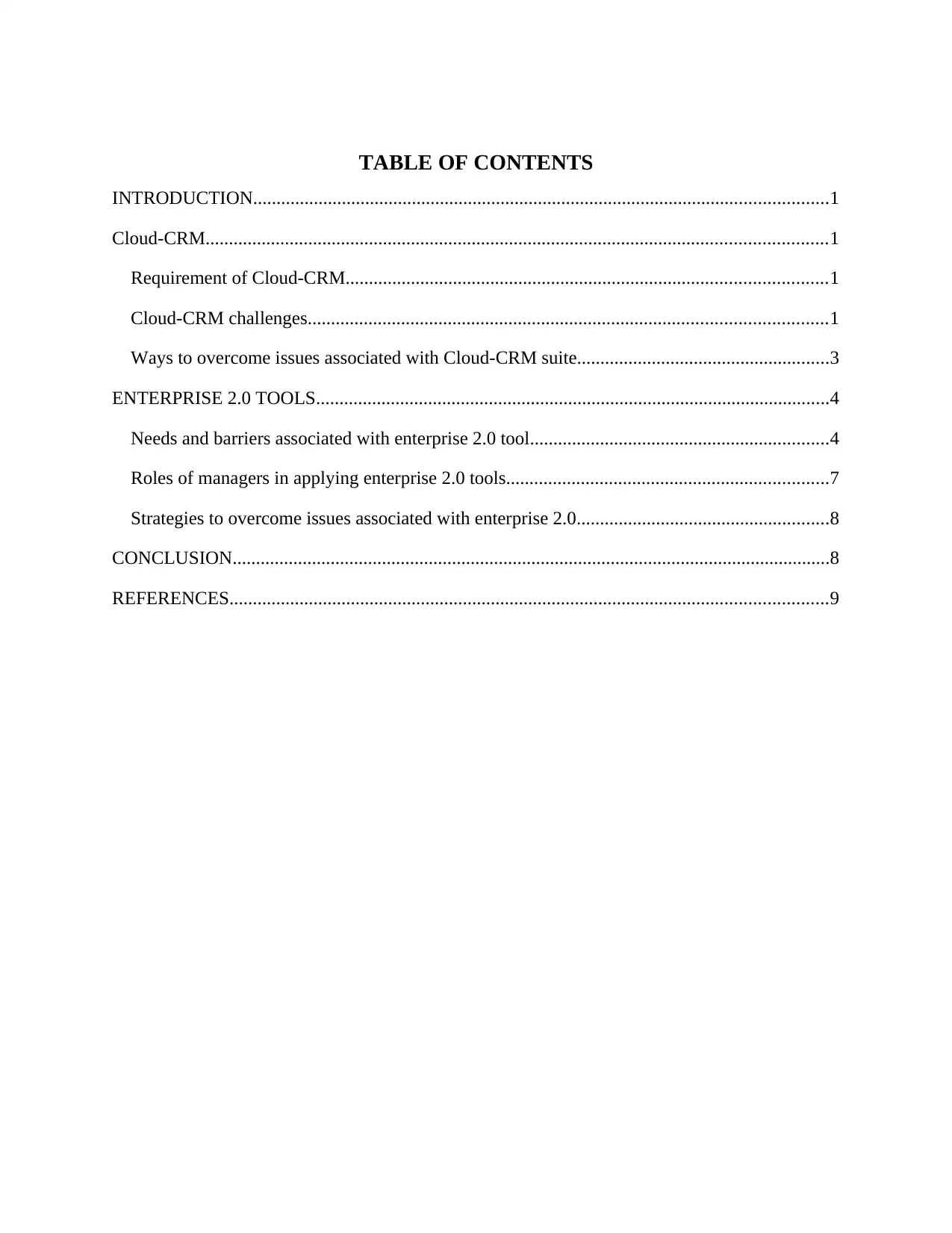
TABLE OF CONTENTS
INTRODUCTION...........................................................................................................................1
Cloud-CRM.....................................................................................................................................1
Requirement of Cloud-CRM.......................................................................................................1
Cloud-CRM challenges...............................................................................................................1
Ways to overcome issues associated with Cloud-CRM suite......................................................3
ENTERPRISE 2.0 TOOLS..............................................................................................................4
Needs and barriers associated with enterprise 2.0 tool................................................................4
Roles of managers in applying enterprise 2.0 tools.....................................................................7
Strategies to overcome issues associated with enterprise 2.0......................................................8
CONCLUSION................................................................................................................................8
REFERENCES................................................................................................................................9
INTRODUCTION...........................................................................................................................1
Cloud-CRM.....................................................................................................................................1
Requirement of Cloud-CRM.......................................................................................................1
Cloud-CRM challenges...............................................................................................................1
Ways to overcome issues associated with Cloud-CRM suite......................................................3
ENTERPRISE 2.0 TOOLS..............................................................................................................4
Needs and barriers associated with enterprise 2.0 tool................................................................4
Roles of managers in applying enterprise 2.0 tools.....................................................................7
Strategies to overcome issues associated with enterprise 2.0......................................................8
CONCLUSION................................................................................................................................8
REFERENCES................................................................................................................................9
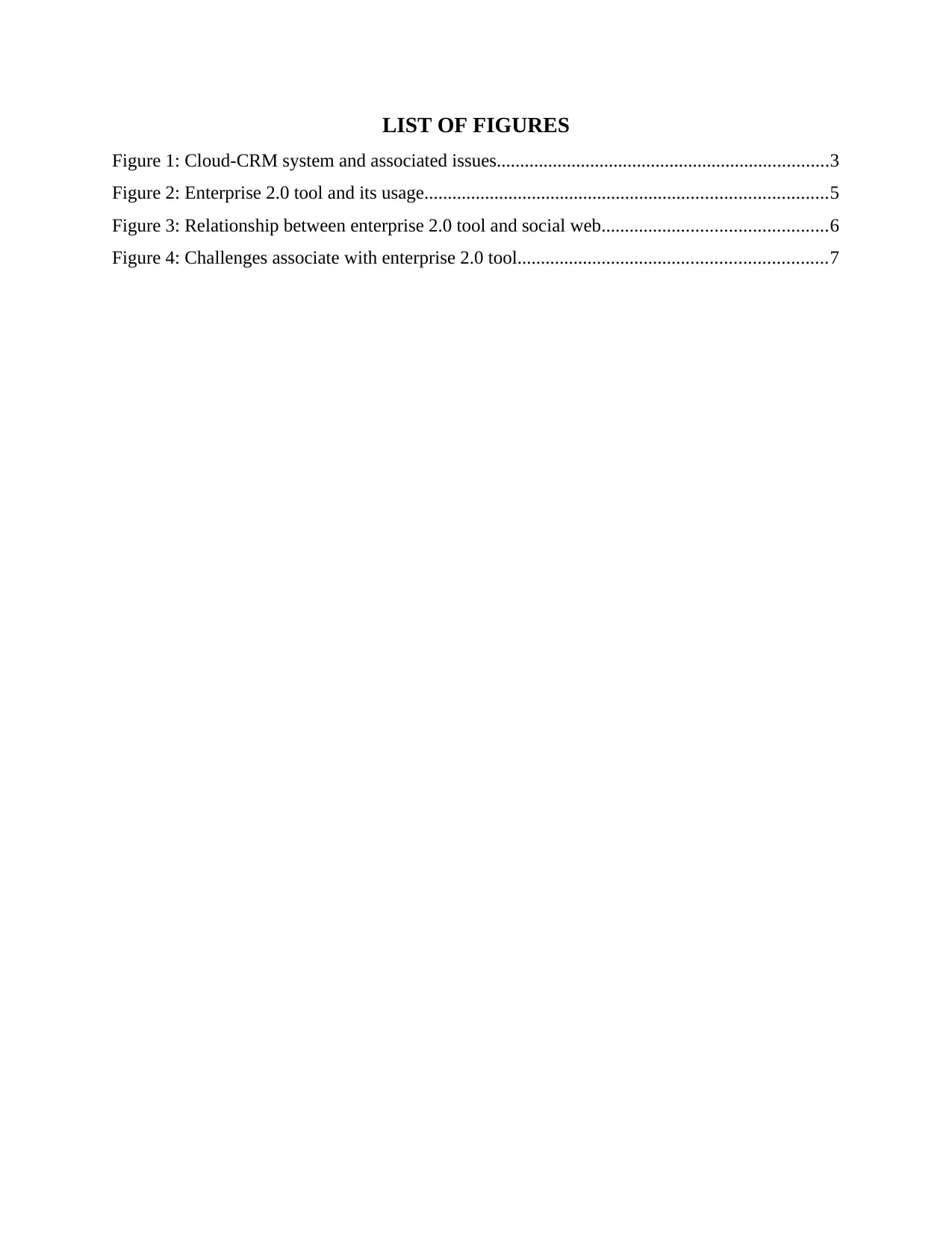
LIST OF FIGURES
Figure 1: Cloud-CRM system and associated issues.......................................................................3
Figure 2: Enterprise 2.0 tool and its usage......................................................................................5
Figure 3: Relationship between enterprise 2.0 tool and social web................................................6
Figure 4: Challenges associate with enterprise 2.0 tool..................................................................7
Figure 1: Cloud-CRM system and associated issues.......................................................................3
Figure 2: Enterprise 2.0 tool and its usage......................................................................................5
Figure 3: Relationship between enterprise 2.0 tool and social web................................................6
Figure 4: Challenges associate with enterprise 2.0 tool..................................................................7
⊘ This is a preview!⊘
Do you want full access?
Subscribe today to unlock all pages.

Trusted by 1+ million students worldwide
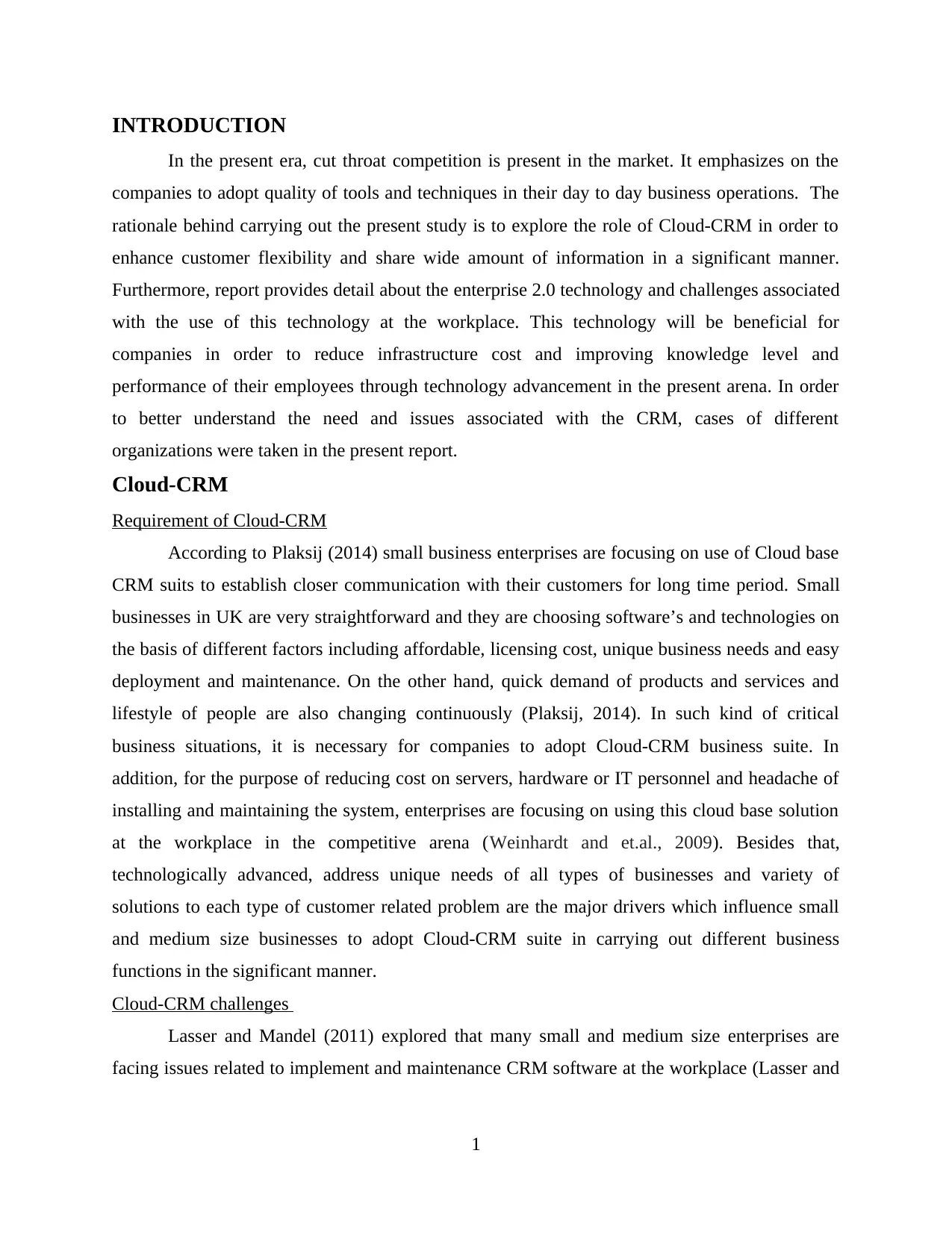
INTRODUCTION
In the present era, cut throat competition is present in the market. It emphasizes on the
companies to adopt quality of tools and techniques in their day to day business operations. The
rationale behind carrying out the present study is to explore the role of Cloud-CRM in order to
enhance customer flexibility and share wide amount of information in a significant manner.
Furthermore, report provides detail about the enterprise 2.0 technology and challenges associated
with the use of this technology at the workplace. This technology will be beneficial for
companies in order to reduce infrastructure cost and improving knowledge level and
performance of their employees through technology advancement in the present arena. In order
to better understand the need and issues associated with the CRM, cases of different
organizations were taken in the present report.
Cloud-CRM
Requirement of Cloud-CRM
According to Plaksij (2014) small business enterprises are focusing on use of Cloud base
CRM suits to establish closer communication with their customers for long time period. Small
businesses in UK are very straightforward and they are choosing software’s and technologies on
the basis of different factors including affordable, licensing cost, unique business needs and easy
deployment and maintenance. On the other hand, quick demand of products and services and
lifestyle of people are also changing continuously (Plaksij, 2014). In such kind of critical
business situations, it is necessary for companies to adopt Cloud-CRM business suite. In
addition, for the purpose of reducing cost on servers, hardware or IT personnel and headache of
installing and maintaining the system, enterprises are focusing on using this cloud base solution
at the workplace in the competitive arena (Weinhardt and et.al., 2009). Besides that,
technologically advanced, address unique needs of all types of businesses and variety of
solutions to each type of customer related problem are the major drivers which influence small
and medium size businesses to adopt Cloud-CRM suite in carrying out different business
functions in the significant manner.
Cloud-CRM challenges
Lasser and Mandel (2011) explored that many small and medium size enterprises are
facing issues related to implement and maintenance CRM software at the workplace (Lasser and
1
In the present era, cut throat competition is present in the market. It emphasizes on the
companies to adopt quality of tools and techniques in their day to day business operations. The
rationale behind carrying out the present study is to explore the role of Cloud-CRM in order to
enhance customer flexibility and share wide amount of information in a significant manner.
Furthermore, report provides detail about the enterprise 2.0 technology and challenges associated
with the use of this technology at the workplace. This technology will be beneficial for
companies in order to reduce infrastructure cost and improving knowledge level and
performance of their employees through technology advancement in the present arena. In order
to better understand the need and issues associated with the CRM, cases of different
organizations were taken in the present report.
Cloud-CRM
Requirement of Cloud-CRM
According to Plaksij (2014) small business enterprises are focusing on use of Cloud base
CRM suits to establish closer communication with their customers for long time period. Small
businesses in UK are very straightforward and they are choosing software’s and technologies on
the basis of different factors including affordable, licensing cost, unique business needs and easy
deployment and maintenance. On the other hand, quick demand of products and services and
lifestyle of people are also changing continuously (Plaksij, 2014). In such kind of critical
business situations, it is necessary for companies to adopt Cloud-CRM business suite. In
addition, for the purpose of reducing cost on servers, hardware or IT personnel and headache of
installing and maintaining the system, enterprises are focusing on using this cloud base solution
at the workplace in the competitive arena (Weinhardt and et.al., 2009). Besides that,
technologically advanced, address unique needs of all types of businesses and variety of
solutions to each type of customer related problem are the major drivers which influence small
and medium size businesses to adopt Cloud-CRM suite in carrying out different business
functions in the significant manner.
Cloud-CRM challenges
Lasser and Mandel (2011) explored that many small and medium size enterprises are
facing issues related to implement and maintenance CRM software at the workplace (Lasser and
1
Paraphrase This Document
Need a fresh take? Get an instant paraphrase of this document with our AI Paraphraser
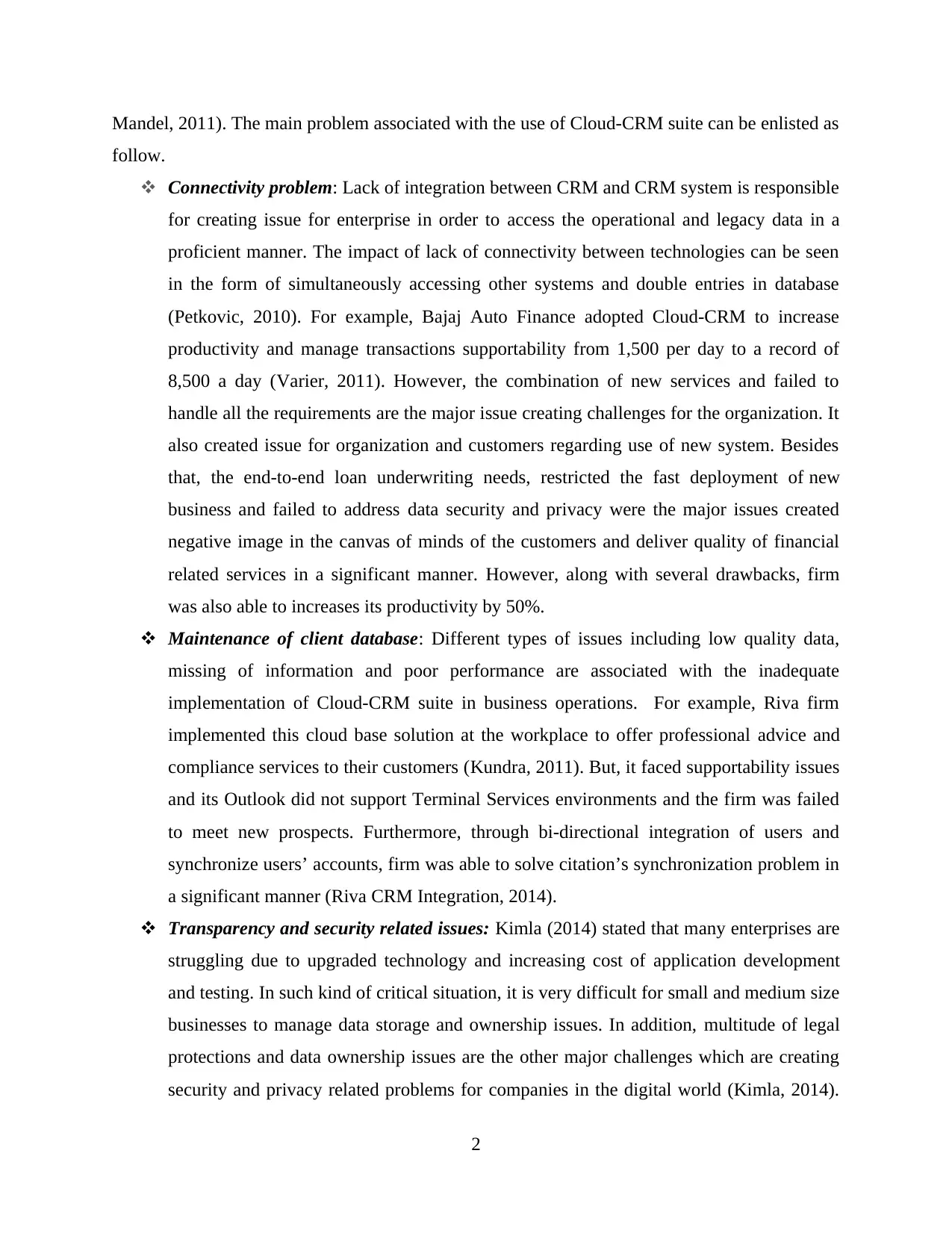
Mandel, 2011). The main problem associated with the use of Cloud-CRM suite can be enlisted as
follow.
Connectivity problem: Lack of integration between CRM and CRM system is responsible
for creating issue for enterprise in order to access the operational and legacy data in a
proficient manner. The impact of lack of connectivity between technologies can be seen
in the form of simultaneously accessing other systems and double entries in database
(Petkovic, 2010). For example, Bajaj Auto Finance adopted Cloud-CRM to increase
productivity and manage transactions supportability from 1,500 per day to a record of
8,500 a day (Varier, 2011). However, the combination of new services and failed to
handle all the requirements are the major issue creating challenges for the organization. It
also created issue for organization and customers regarding use of new system. Besides
that, the end-to-end loan underwriting needs, restricted the fast deployment of new
business and failed to address data security and privacy were the major issues created
negative image in the canvas of minds of the customers and deliver quality of financial
related services in a significant manner. However, along with several drawbacks, firm
was also able to increases its productivity by 50%.
Maintenance of client database: Different types of issues including low quality data,
missing of information and poor performance are associated with the inadequate
implementation of Cloud-CRM suite in business operations. For example, Riva firm
implemented this cloud base solution at the workplace to offer professional advice and
compliance services to their customers (Kundra, 2011). But, it faced supportability issues
and its Outlook did not support Terminal Services environments and the firm was failed
to meet new prospects. Furthermore, through bi-directional integration of users and
synchronize users’ accounts, firm was able to solve citation’s synchronization problem in
a significant manner (Riva CRM Integration, 2014).
Transparency and security related issues: Kimla (2014) stated that many enterprises are
struggling due to upgraded technology and increasing cost of application development
and testing. In such kind of critical situation, it is very difficult for small and medium size
businesses to manage data storage and ownership issues. In addition, multitude of legal
protections and data ownership issues are the other major challenges which are creating
security and privacy related problems for companies in the digital world (Kimla, 2014).
2
follow.
Connectivity problem: Lack of integration between CRM and CRM system is responsible
for creating issue for enterprise in order to access the operational and legacy data in a
proficient manner. The impact of lack of connectivity between technologies can be seen
in the form of simultaneously accessing other systems and double entries in database
(Petkovic, 2010). For example, Bajaj Auto Finance adopted Cloud-CRM to increase
productivity and manage transactions supportability from 1,500 per day to a record of
8,500 a day (Varier, 2011). However, the combination of new services and failed to
handle all the requirements are the major issue creating challenges for the organization. It
also created issue for organization and customers regarding use of new system. Besides
that, the end-to-end loan underwriting needs, restricted the fast deployment of new
business and failed to address data security and privacy were the major issues created
negative image in the canvas of minds of the customers and deliver quality of financial
related services in a significant manner. However, along with several drawbacks, firm
was also able to increases its productivity by 50%.
Maintenance of client database: Different types of issues including low quality data,
missing of information and poor performance are associated with the inadequate
implementation of Cloud-CRM suite in business operations. For example, Riva firm
implemented this cloud base solution at the workplace to offer professional advice and
compliance services to their customers (Kundra, 2011). But, it faced supportability issues
and its Outlook did not support Terminal Services environments and the firm was failed
to meet new prospects. Furthermore, through bi-directional integration of users and
synchronize users’ accounts, firm was able to solve citation’s synchronization problem in
a significant manner (Riva CRM Integration, 2014).
Transparency and security related issues: Kimla (2014) stated that many enterprises are
struggling due to upgraded technology and increasing cost of application development
and testing. In such kind of critical situation, it is very difficult for small and medium size
businesses to manage data storage and ownership issues. In addition, multitude of legal
protections and data ownership issues are the other major challenges which are creating
security and privacy related problems for companies in the digital world (Kimla, 2014).
2
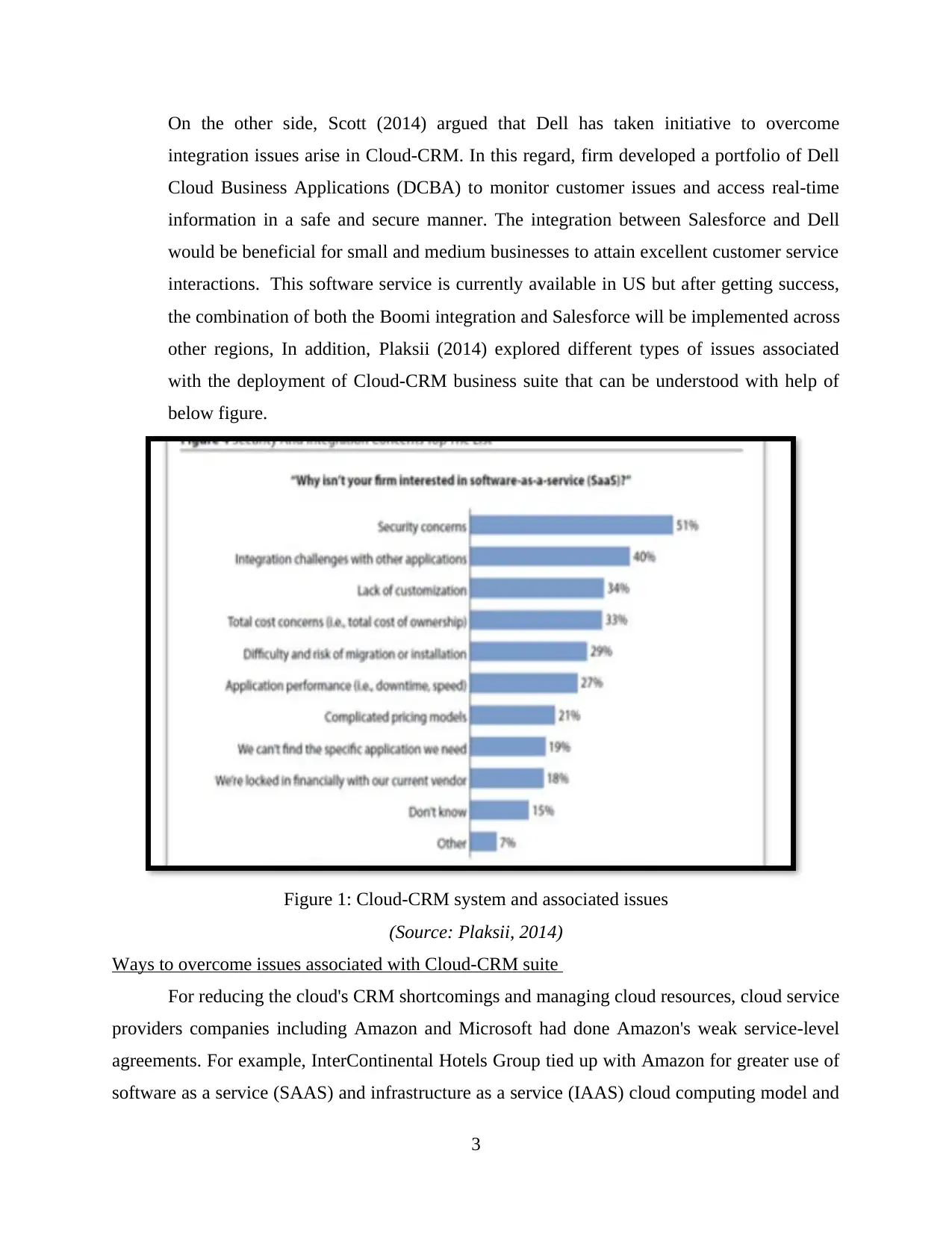
On the other side, Scott (2014) argued that Dell has taken initiative to overcome
integration issues arise in Cloud-CRM. In this regard, firm developed a portfolio of Dell
Cloud Business Applications (DCBA) to monitor customer issues and access real-time
information in a safe and secure manner. The integration between Salesforce and Dell
would be beneficial for small and medium businesses to attain excellent customer service
interactions. This software service is currently available in US but after getting success,
the combination of both the Boomi integration and Salesforce will be implemented across
other regions, In addition, Plaksii (2014) explored different types of issues associated
with the deployment of Cloud-CRM business suite that can be understood with help of
below figure.
Figure 1: Cloud-CRM system and associated issues
(Source: Plaksii, 2014)
Ways to overcome issues associated with Cloud-CRM suite
For reducing the cloud's CRM shortcomings and managing cloud resources, cloud service
providers companies including Amazon and Microsoft had done Amazon's weak service-level
agreements. For example, InterContinental Hotels Group tied up with Amazon for greater use of
software as a service (SAAS) and infrastructure as a service (IAAS) cloud computing model and
3
integration issues arise in Cloud-CRM. In this regard, firm developed a portfolio of Dell
Cloud Business Applications (DCBA) to monitor customer issues and access real-time
information in a safe and secure manner. The integration between Salesforce and Dell
would be beneficial for small and medium businesses to attain excellent customer service
interactions. This software service is currently available in US but after getting success,
the combination of both the Boomi integration and Salesforce will be implemented across
other regions, In addition, Plaksii (2014) explored different types of issues associated
with the deployment of Cloud-CRM business suite that can be understood with help of
below figure.
Figure 1: Cloud-CRM system and associated issues
(Source: Plaksii, 2014)
Ways to overcome issues associated with Cloud-CRM suite
For reducing the cloud's CRM shortcomings and managing cloud resources, cloud service
providers companies including Amazon and Microsoft had done Amazon's weak service-level
agreements. For example, InterContinental Hotels Group tied up with Amazon for greater use of
software as a service (SAAS) and infrastructure as a service (IAAS) cloud computing model and
3
⊘ This is a preview!⊘
Do you want full access?
Subscribe today to unlock all pages.

Trusted by 1+ million students worldwide
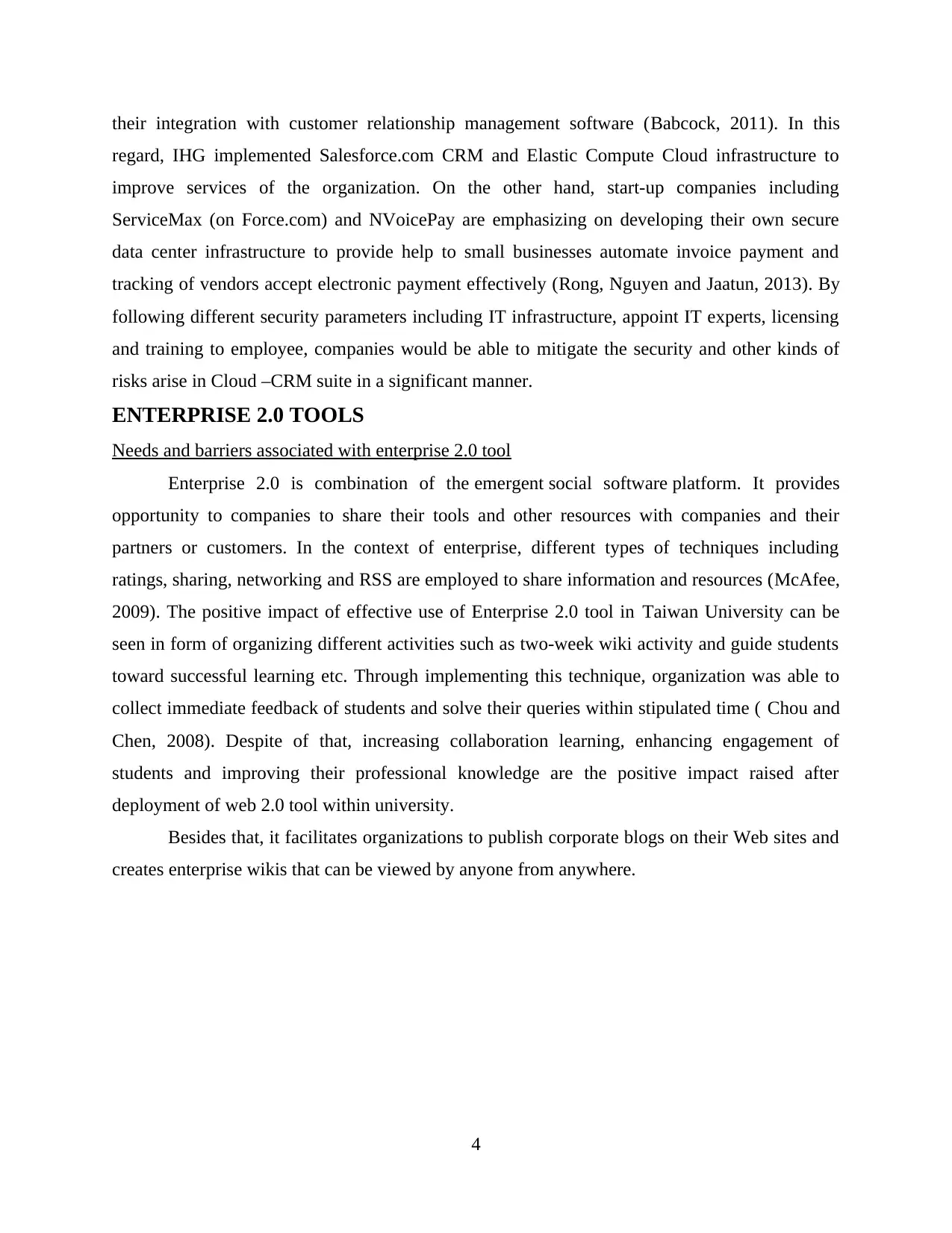
their integration with customer relationship management software (Babcock, 2011). In this
regard, IHG implemented Salesforce.com CRM and Elastic Compute Cloud infrastructure to
improve services of the organization. On the other hand, start-up companies including
ServiceMax (on Force.com) and NVoicePay are emphasizing on developing their own secure
data center infrastructure to provide help to small businesses automate invoice payment and
tracking of vendors accept electronic payment effectively (Rong, Nguyen and Jaatun, 2013). By
following different security parameters including IT infrastructure, appoint IT experts, licensing
and training to employee, companies would be able to mitigate the security and other kinds of
risks arise in Cloud –CRM suite in a significant manner.
ENTERPRISE 2.0 TOOLS
Needs and barriers associated with enterprise 2.0 tool
Enterprise 2.0 is combination of the emergent social software platform. It provides
opportunity to companies to share their tools and other resources with companies and their
partners or customers. In the context of enterprise, different types of techniques including
ratings, sharing, networking and RSS are employed to share information and resources (McAfee,
2009). The positive impact of effective use of Enterprise 2.0 tool in Taiwan University can be
seen in form of organizing different activities such as two-week wiki activity and guide students
toward successful learning etc. Through implementing this technique, organization was able to
collect immediate feedback of students and solve their queries within stipulated time ( Chou and
Chen, 2008). Despite of that, increasing collaboration learning, enhancing engagement of
students and improving their professional knowledge are the positive impact raised after
deployment of web 2.0 tool within university.
Besides that, it facilitates organizations to publish corporate blogs on their Web sites and
creates enterprise wikis that can be viewed by anyone from anywhere.
4
regard, IHG implemented Salesforce.com CRM and Elastic Compute Cloud infrastructure to
improve services of the organization. On the other hand, start-up companies including
ServiceMax (on Force.com) and NVoicePay are emphasizing on developing their own secure
data center infrastructure to provide help to small businesses automate invoice payment and
tracking of vendors accept electronic payment effectively (Rong, Nguyen and Jaatun, 2013). By
following different security parameters including IT infrastructure, appoint IT experts, licensing
and training to employee, companies would be able to mitigate the security and other kinds of
risks arise in Cloud –CRM suite in a significant manner.
ENTERPRISE 2.0 TOOLS
Needs and barriers associated with enterprise 2.0 tool
Enterprise 2.0 is combination of the emergent social software platform. It provides
opportunity to companies to share their tools and other resources with companies and their
partners or customers. In the context of enterprise, different types of techniques including
ratings, sharing, networking and RSS are employed to share information and resources (McAfee,
2009). The positive impact of effective use of Enterprise 2.0 tool in Taiwan University can be
seen in form of organizing different activities such as two-week wiki activity and guide students
toward successful learning etc. Through implementing this technique, organization was able to
collect immediate feedback of students and solve their queries within stipulated time ( Chou and
Chen, 2008). Despite of that, increasing collaboration learning, enhancing engagement of
students and improving their professional knowledge are the positive impact raised after
deployment of web 2.0 tool within university.
Besides that, it facilitates organizations to publish corporate blogs on their Web sites and
creates enterprise wikis that can be viewed by anyone from anywhere.
4
Paraphrase This Document
Need a fresh take? Get an instant paraphrase of this document with our AI Paraphraser
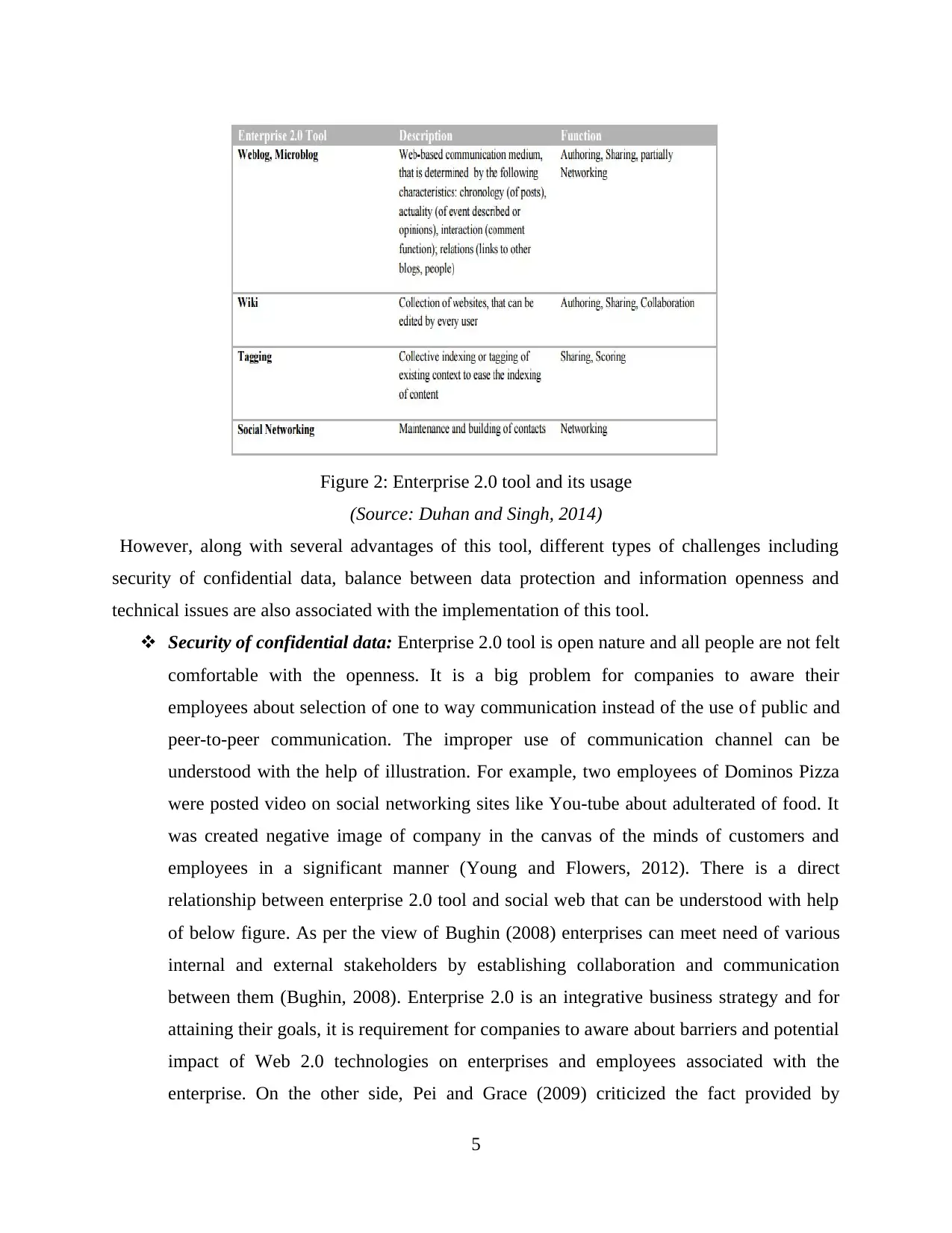
Figure 2: Enterprise 2.0 tool and its usage
(Source: Duhan and Singh, 2014)
However, along with several advantages of this tool, different types of challenges including
security of confidential data, balance between data protection and information openness and
technical issues are also associated with the implementation of this tool.
Security of confidential data: Enterprise 2.0 tool is open nature and all people are not felt
comfortable with the openness. It is a big problem for companies to aware their
employees about selection of one to way communication instead of the use of public and
peer-to-peer communication. The improper use of communication channel can be
understood with the help of illustration. For example, two employees of Dominos Pizza
were posted video on social networking sites like You-tube about adulterated of food. It
was created negative image of company in the canvas of the minds of customers and
employees in a significant manner (Young and Flowers, 2012). There is a direct
relationship between enterprise 2.0 tool and social web that can be understood with help
of below figure. As per the view of Bughin (2008) enterprises can meet need of various
internal and external stakeholders by establishing collaboration and communication
between them (Bughin, 2008). Enterprise 2.0 is an integrative business strategy and for
attaining their goals, it is requirement for companies to aware about barriers and potential
impact of Web 2.0 technologies on enterprises and employees associated with the
enterprise. On the other side, Pei and Grace (2009) criticized the fact provided by
5
(Source: Duhan and Singh, 2014)
However, along with several advantages of this tool, different types of challenges including
security of confidential data, balance between data protection and information openness and
technical issues are also associated with the implementation of this tool.
Security of confidential data: Enterprise 2.0 tool is open nature and all people are not felt
comfortable with the openness. It is a big problem for companies to aware their
employees about selection of one to way communication instead of the use of public and
peer-to-peer communication. The improper use of communication channel can be
understood with the help of illustration. For example, two employees of Dominos Pizza
were posted video on social networking sites like You-tube about adulterated of food. It
was created negative image of company in the canvas of the minds of customers and
employees in a significant manner (Young and Flowers, 2012). There is a direct
relationship between enterprise 2.0 tool and social web that can be understood with help
of below figure. As per the view of Bughin (2008) enterprises can meet need of various
internal and external stakeholders by establishing collaboration and communication
between them (Bughin, 2008). Enterprise 2.0 is an integrative business strategy and for
attaining their goals, it is requirement for companies to aware about barriers and potential
impact of Web 2.0 technologies on enterprises and employees associated with the
enterprise. On the other side, Pei and Grace (2009) criticized the fact provided by
5
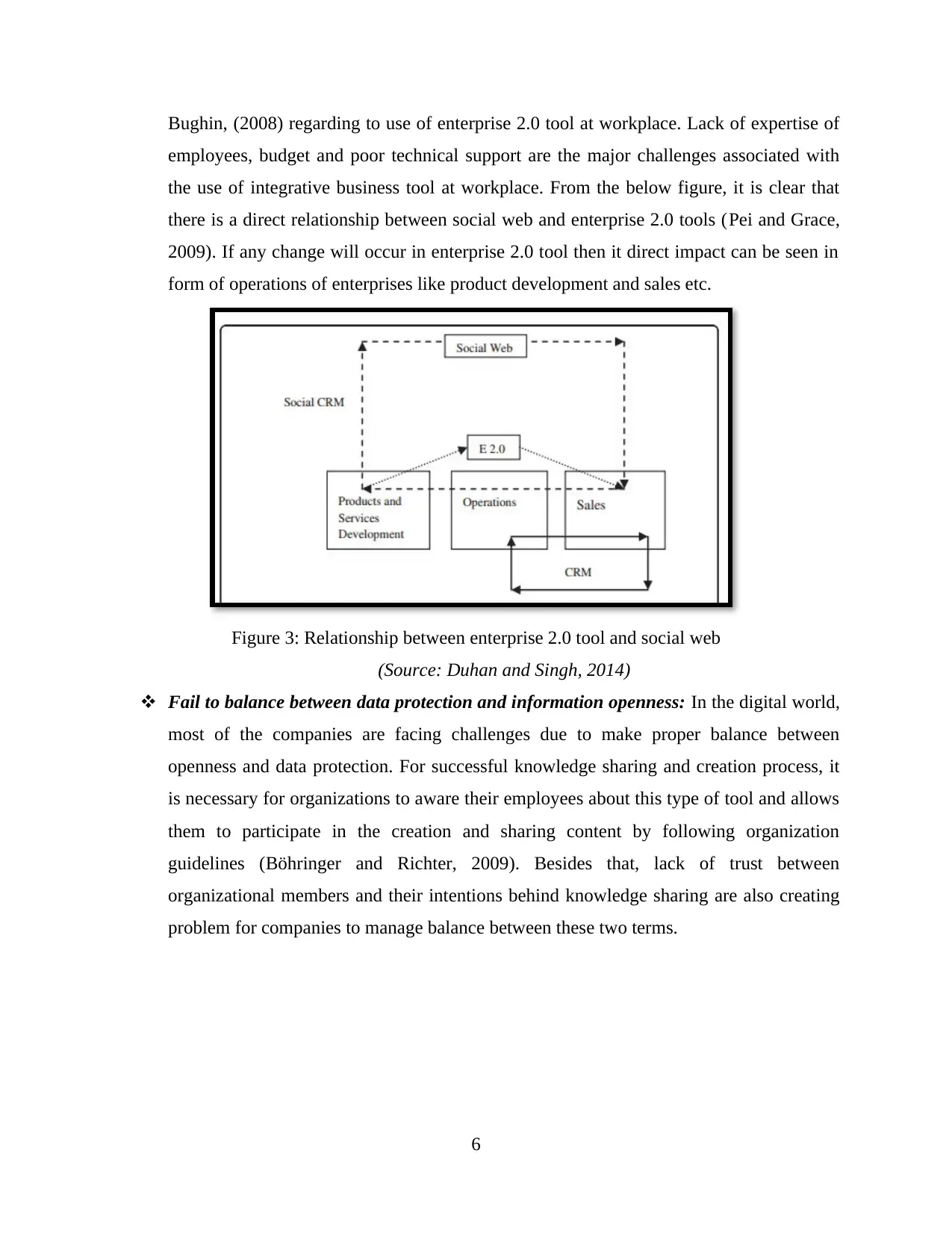
Bughin, (2008) regarding to use of enterprise 2.0 tool at workplace. Lack of expertise of
employees, budget and poor technical support are the major challenges associated with
the use of integrative business tool at workplace. From the below figure, it is clear that
there is a direct relationship between social web and enterprise 2.0 tools (Pei and Grace,
2009). If any change will occur in enterprise 2.0 tool then it direct impact can be seen in
form of operations of enterprises like product development and sales etc.
Figure 3: Relationship between enterprise 2.0 tool and social web
(Source: Duhan and Singh, 2014)
Fail to balance between data protection and information openness: In the digital world,
most of the companies are facing challenges due to make proper balance between
openness and data protection. For successful knowledge sharing and creation process, it
is necessary for organizations to aware their employees about this type of tool and allows
them to participate in the creation and sharing content by following organization
guidelines (Böhringer and Richter, 2009). Besides that, lack of trust between
organizational members and their intentions behind knowledge sharing are also creating
problem for companies to manage balance between these two terms.
6
employees, budget and poor technical support are the major challenges associated with
the use of integrative business tool at workplace. From the below figure, it is clear that
there is a direct relationship between social web and enterprise 2.0 tools (Pei and Grace,
2009). If any change will occur in enterprise 2.0 tool then it direct impact can be seen in
form of operations of enterprises like product development and sales etc.
Figure 3: Relationship between enterprise 2.0 tool and social web
(Source: Duhan and Singh, 2014)
Fail to balance between data protection and information openness: In the digital world,
most of the companies are facing challenges due to make proper balance between
openness and data protection. For successful knowledge sharing and creation process, it
is necessary for organizations to aware their employees about this type of tool and allows
them to participate in the creation and sharing content by following organization
guidelines (Böhringer and Richter, 2009). Besides that, lack of trust between
organizational members and their intentions behind knowledge sharing are also creating
problem for companies to manage balance between these two terms.
6
⊘ This is a preview!⊘
Do you want full access?
Subscribe today to unlock all pages.

Trusted by 1+ million students worldwide
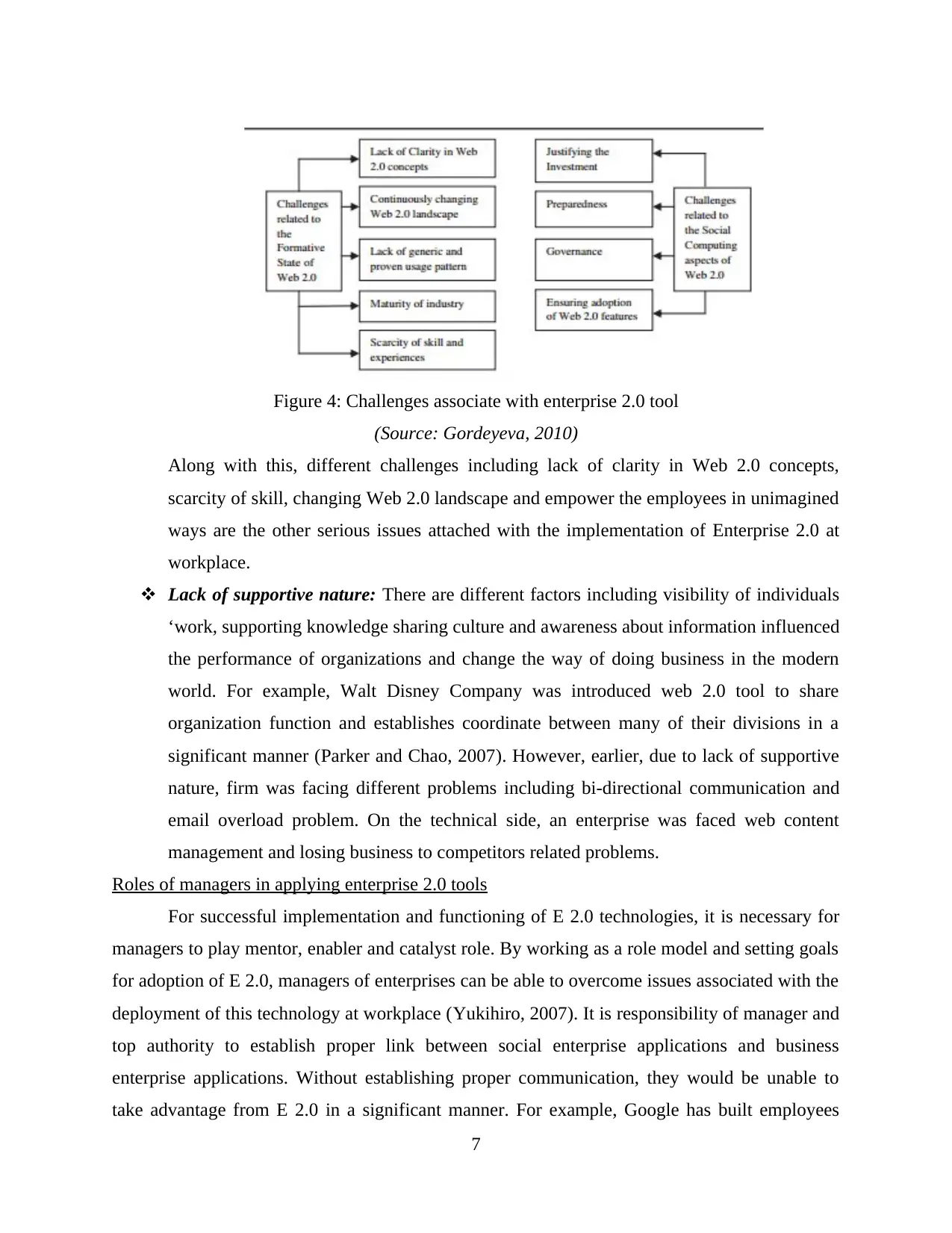
Figure 4: Challenges associate with enterprise 2.0 tool
(Source: Gordeyeva, 2010)
Along with this, different challenges including lack of clarity in Web 2.0 concepts,
scarcity of skill, changing Web 2.0 landscape and empower the employees in unimagined
ways are the other serious issues attached with the implementation of Enterprise 2.0 at
workplace.
Lack of supportive nature: There are different factors including visibility of individuals
‘work, supporting knowledge sharing culture and awareness about information influenced
the performance of organizations and change the way of doing business in the modern
world. For example, Walt Disney Company was introduced web 2.0 tool to share
organization function and establishes coordinate between many of their divisions in a
significant manner (Parker and Chao, 2007). However, earlier, due to lack of supportive
nature, firm was facing different problems including bi-directional communication and
email overload problem. On the technical side, an enterprise was faced web content
management and losing business to competitors related problems.
Roles of managers in applying enterprise 2.0 tools
For successful implementation and functioning of E 2.0 technologies, it is necessary for
managers to play mentor, enabler and catalyst role. By working as a role model and setting goals
for adoption of E 2.0, managers of enterprises can be able to overcome issues associated with the
deployment of this technology at workplace (Yukihiro, 2007). It is responsibility of manager and
top authority to establish proper link between social enterprise applications and business
enterprise applications. Without establishing proper communication, they would be unable to
take advantage from E 2.0 in a significant manner. For example, Google has built employees
7
(Source: Gordeyeva, 2010)
Along with this, different challenges including lack of clarity in Web 2.0 concepts,
scarcity of skill, changing Web 2.0 landscape and empower the employees in unimagined
ways are the other serious issues attached with the implementation of Enterprise 2.0 at
workplace.
Lack of supportive nature: There are different factors including visibility of individuals
‘work, supporting knowledge sharing culture and awareness about information influenced
the performance of organizations and change the way of doing business in the modern
world. For example, Walt Disney Company was introduced web 2.0 tool to share
organization function and establishes coordinate between many of their divisions in a
significant manner (Parker and Chao, 2007). However, earlier, due to lack of supportive
nature, firm was facing different problems including bi-directional communication and
email overload problem. On the technical side, an enterprise was faced web content
management and losing business to competitors related problems.
Roles of managers in applying enterprise 2.0 tools
For successful implementation and functioning of E 2.0 technologies, it is necessary for
managers to play mentor, enabler and catalyst role. By working as a role model and setting goals
for adoption of E 2.0, managers of enterprises can be able to overcome issues associated with the
deployment of this technology at workplace (Yukihiro, 2007). It is responsibility of manager and
top authority to establish proper link between social enterprise applications and business
enterprise applications. Without establishing proper communication, they would be unable to
take advantage from E 2.0 in a significant manner. For example, Google has built employees
7
Paraphrase This Document
Need a fresh take? Get an instant paraphrase of this document with our AI Paraphraser
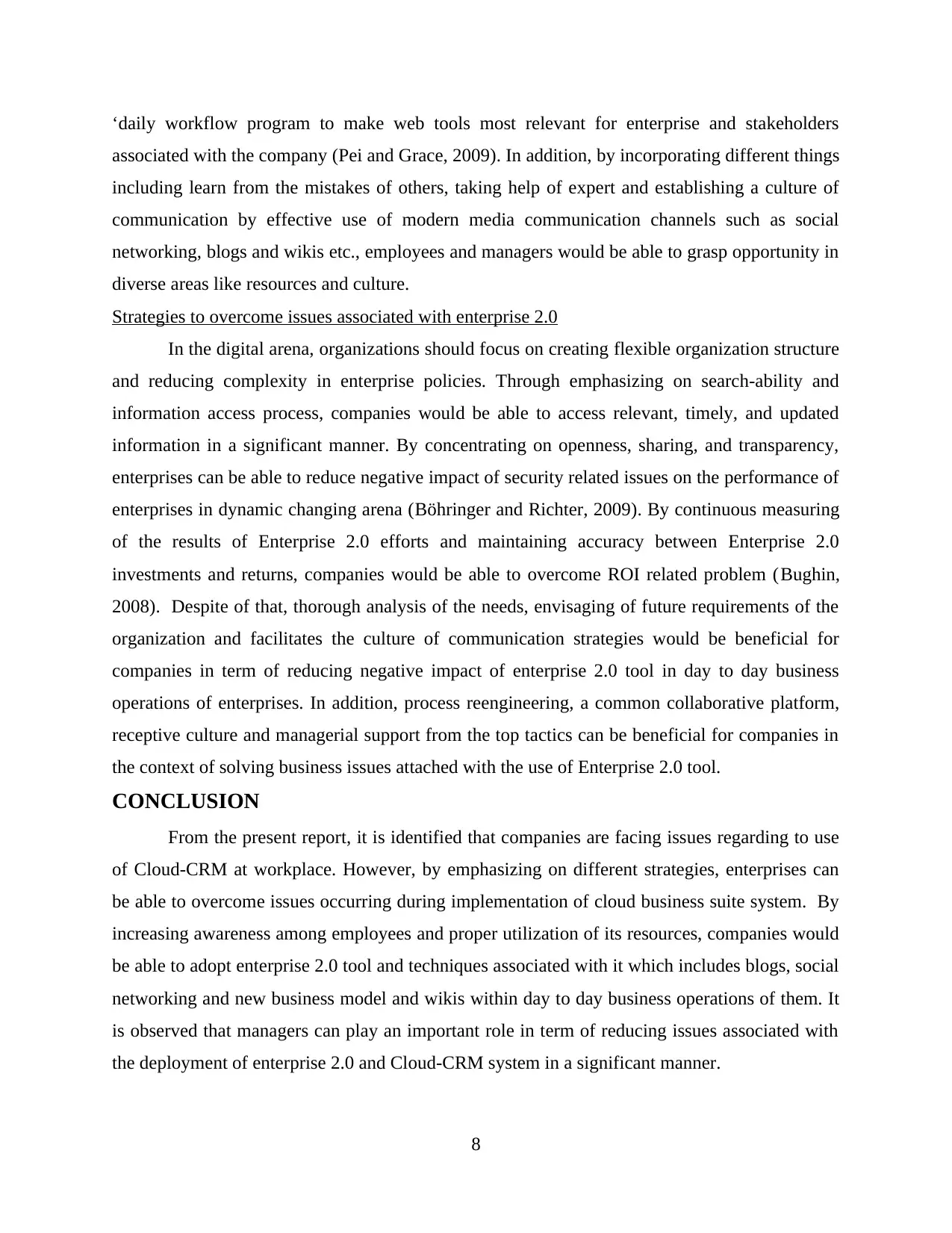
‘daily workflow program to make web tools most relevant for enterprise and stakeholders
associated with the company (Pei and Grace, 2009). In addition, by incorporating different things
including learn from the mistakes of others, taking help of expert and establishing a culture of
communication by effective use of modern media communication channels such as social
networking, blogs and wikis etc., employees and managers would be able to grasp opportunity in
diverse areas like resources and culture.
Strategies to overcome issues associated with enterprise 2.0
In the digital arena, organizations should focus on creating flexible organization structure
and reducing complexity in enterprise policies. Through emphasizing on search-ability and
information access process, companies would be able to access relevant, timely, and updated
information in a significant manner. By concentrating on openness, sharing, and transparency,
enterprises can be able to reduce negative impact of security related issues on the performance of
enterprises in dynamic changing arena (Böhringer and Richter, 2009). By continuous measuring
of the results of Enterprise 2.0 efforts and maintaining accuracy between Enterprise 2.0
investments and returns, companies would be able to overcome ROI related problem (Bughin,
2008). Despite of that, thorough analysis of the needs, envisaging of future requirements of the
organization and facilitates the culture of communication strategies would be beneficial for
companies in term of reducing negative impact of enterprise 2.0 tool in day to day business
operations of enterprises. In addition, process reengineering, a common collaborative platform,
receptive culture and managerial support from the top tactics can be beneficial for companies in
the context of solving business issues attached with the use of Enterprise 2.0 tool.
CONCLUSION
From the present report, it is identified that companies are facing issues regarding to use
of Cloud-CRM at workplace. However, by emphasizing on different strategies, enterprises can
be able to overcome issues occurring during implementation of cloud business suite system. By
increasing awareness among employees and proper utilization of its resources, companies would
be able to adopt enterprise 2.0 tool and techniques associated with it which includes blogs, social
networking and new business model and wikis within day to day business operations of them. It
is observed that managers can play an important role in term of reducing issues associated with
the deployment of enterprise 2.0 and Cloud-CRM system in a significant manner.
8
associated with the company (Pei and Grace, 2009). In addition, by incorporating different things
including learn from the mistakes of others, taking help of expert and establishing a culture of
communication by effective use of modern media communication channels such as social
networking, blogs and wikis etc., employees and managers would be able to grasp opportunity in
diverse areas like resources and culture.
Strategies to overcome issues associated with enterprise 2.0
In the digital arena, organizations should focus on creating flexible organization structure
and reducing complexity in enterprise policies. Through emphasizing on search-ability and
information access process, companies would be able to access relevant, timely, and updated
information in a significant manner. By concentrating on openness, sharing, and transparency,
enterprises can be able to reduce negative impact of security related issues on the performance of
enterprises in dynamic changing arena (Böhringer and Richter, 2009). By continuous measuring
of the results of Enterprise 2.0 efforts and maintaining accuracy between Enterprise 2.0
investments and returns, companies would be able to overcome ROI related problem (Bughin,
2008). Despite of that, thorough analysis of the needs, envisaging of future requirements of the
organization and facilitates the culture of communication strategies would be beneficial for
companies in term of reducing negative impact of enterprise 2.0 tool in day to day business
operations of enterprises. In addition, process reengineering, a common collaborative platform,
receptive culture and managerial support from the top tactics can be beneficial for companies in
the context of solving business issues attached with the use of Enterprise 2.0 tool.
CONCLUSION
From the present report, it is identified that companies are facing issues regarding to use
of Cloud-CRM at workplace. However, by emphasizing on different strategies, enterprises can
be able to overcome issues occurring during implementation of cloud business suite system. By
increasing awareness among employees and proper utilization of its resources, companies would
be able to adopt enterprise 2.0 tool and techniques associated with it which includes blogs, social
networking and new business model and wikis within day to day business operations of them. It
is observed that managers can play an important role in term of reducing issues associated with
the deployment of enterprise 2.0 and Cloud-CRM system in a significant manner.
8
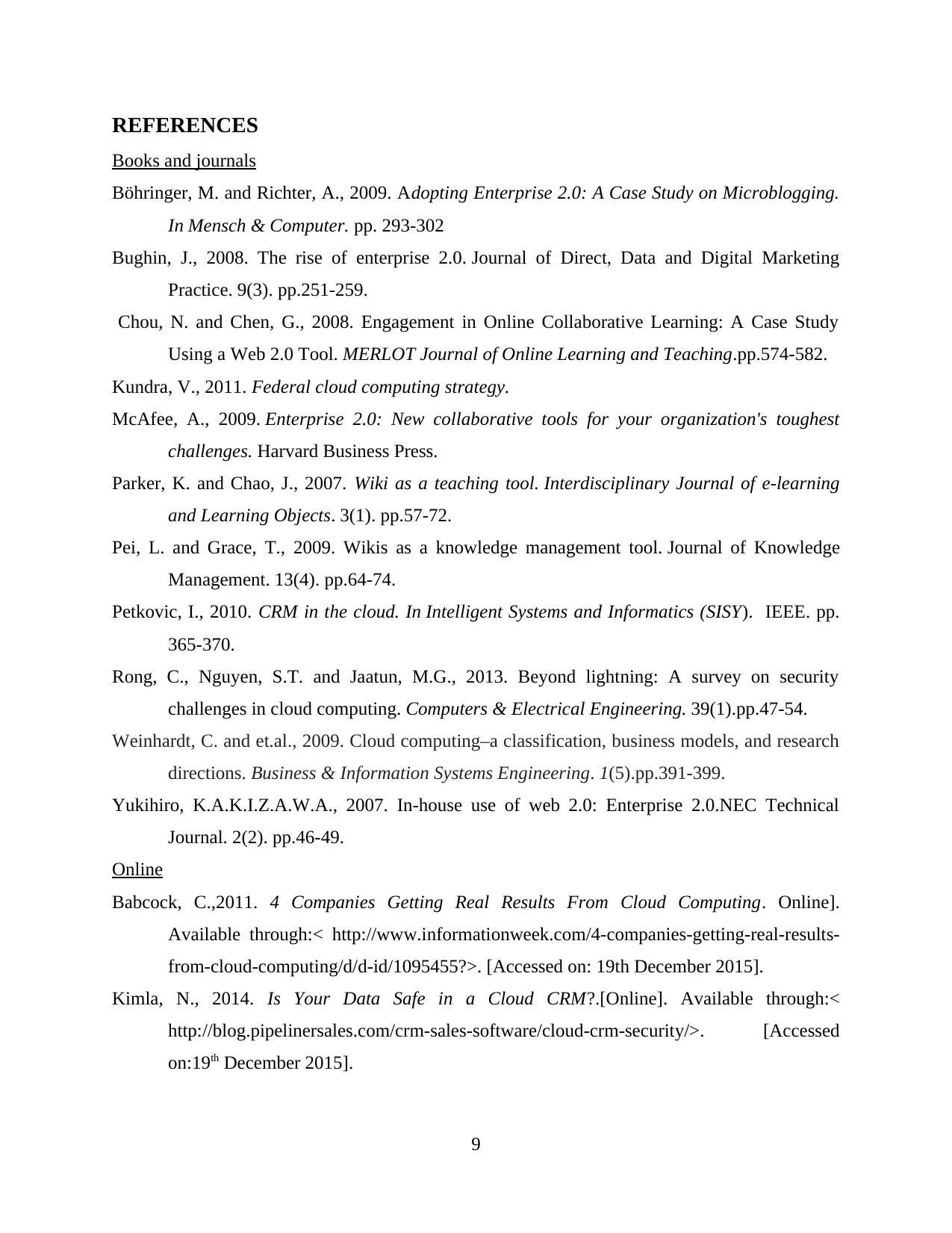
REFERENCES
Books and journals
Böhringer, M. and Richter, A., 2009. Adopting Enterprise 2.0: A Case Study on Microblogging.
In Mensch & Computer. pp. 293-302
Bughin, J., 2008. The rise of enterprise 2.0. Journal of Direct, Data and Digital Marketing
Practice. 9(3). pp.251-259.
Chou, N. and Chen, G., 2008. Engagement in Online Collaborative Learning: A Case Study
Using a Web 2.0 Tool. MERLOT Journal of Online Learning and Teaching.pp.574-582.
Kundra, V., 2011. Federal cloud computing strategy.
McAfee, A., 2009. Enterprise 2.0: New collaborative tools for your organization's toughest
challenges. Harvard Business Press.
Parker, K. and Chao, J., 2007. Wiki as a teaching tool. Interdisciplinary Journal of e-learning
and Learning Objects. 3(1). pp.57-72.
Pei, L. and Grace, T., 2009. Wikis as a knowledge management tool. Journal of Knowledge
Management. 13(4). pp.64-74.
Petkovic, I., 2010. CRM in the cloud. In Intelligent Systems and Informatics (SISY). IEEE. pp.
365-370.
Rong, C., Nguyen, S.T. and Jaatun, M.G., 2013. Beyond lightning: A survey on security
challenges in cloud computing. Computers & Electrical Engineering. 39(1).pp.47-54.
Weinhardt, C. and et.al., 2009. Cloud computing–a classification, business models, and research
directions. Business & Information Systems Engineering. 1(5).pp.391-399.
Yukihiro, K.A.K.I.Z.A.W.A., 2007. In-house use of web 2.0: Enterprise 2.0.NEC Technical
Journal. 2(2). pp.46-49.
Online
Babcock, C.,2011. 4 Companies Getting Real Results From Cloud Computing. Online].
Available through:< http://www.informationweek.com/4-companies-getting-real-results-
from-cloud-computing/d/d-id/1095455?>. [Accessed on: 19th December 2015].
Kimla, N., 2014. Is Your Data Safe in a Cloud CRM?.[Online]. Available through:<
http://blog.pipelinersales.com/crm-sales-software/cloud-crm-security/>. [Accessed
on:19th December 2015].
9
Books and journals
Böhringer, M. and Richter, A., 2009. Adopting Enterprise 2.0: A Case Study on Microblogging.
In Mensch & Computer. pp. 293-302
Bughin, J., 2008. The rise of enterprise 2.0. Journal of Direct, Data and Digital Marketing
Practice. 9(3). pp.251-259.
Chou, N. and Chen, G., 2008. Engagement in Online Collaborative Learning: A Case Study
Using a Web 2.0 Tool. MERLOT Journal of Online Learning and Teaching.pp.574-582.
Kundra, V., 2011. Federal cloud computing strategy.
McAfee, A., 2009. Enterprise 2.0: New collaborative tools for your organization's toughest
challenges. Harvard Business Press.
Parker, K. and Chao, J., 2007. Wiki as a teaching tool. Interdisciplinary Journal of e-learning
and Learning Objects. 3(1). pp.57-72.
Pei, L. and Grace, T., 2009. Wikis as a knowledge management tool. Journal of Knowledge
Management. 13(4). pp.64-74.
Petkovic, I., 2010. CRM in the cloud. In Intelligent Systems and Informatics (SISY). IEEE. pp.
365-370.
Rong, C., Nguyen, S.T. and Jaatun, M.G., 2013. Beyond lightning: A survey on security
challenges in cloud computing. Computers & Electrical Engineering. 39(1).pp.47-54.
Weinhardt, C. and et.al., 2009. Cloud computing–a classification, business models, and research
directions. Business & Information Systems Engineering. 1(5).pp.391-399.
Yukihiro, K.A.K.I.Z.A.W.A., 2007. In-house use of web 2.0: Enterprise 2.0.NEC Technical
Journal. 2(2). pp.46-49.
Online
Babcock, C.,2011. 4 Companies Getting Real Results From Cloud Computing. Online].
Available through:< http://www.informationweek.com/4-companies-getting-real-results-
from-cloud-computing/d/d-id/1095455?>. [Accessed on: 19th December 2015].
Kimla, N., 2014. Is Your Data Safe in a Cloud CRM?.[Online]. Available through:<
http://blog.pipelinersales.com/crm-sales-software/cloud-crm-security/>. [Accessed
on:19th December 2015].
9
⊘ This is a preview!⊘
Do you want full access?
Subscribe today to unlock all pages.

Trusted by 1+ million students worldwide
1 out of 13
Related Documents
Your All-in-One AI-Powered Toolkit for Academic Success.
+13062052269
info@desklib.com
Available 24*7 on WhatsApp / Email
![[object Object]](/_next/static/media/star-bottom.7253800d.svg)
Unlock your academic potential
Copyright © 2020–2025 A2Z Services. All Rights Reserved. Developed and managed by ZUCOL.





